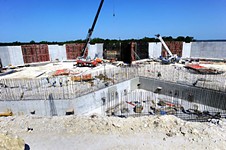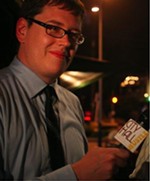The Park Is in the PUD-ing
Council approves Park PUD despite neighborhood opposition
By Wells Dunbar, Fri., Jan. 21, 2011
Credit the win to a concerted advocates' supporting campaign. A press release titled "Environmental Leaders for the Park" – disseminated by political consultant Mike Blizzard and undersigned by names like Ted Siff, Jeb Boyt, and others – touted the project's ability to "reduce traffic congestion," promote green building, and grow Austin's tax base, points reiterated by dozens of speakers and signatories in favor of the building. Opponents, meanwhile, said approving the PUD would set a dangerous precedent, argued that it would destroy Austinites' faith in their government, and even compared the project to Bush administration malfeasance, describing the council as would-be "deciders" acting without considering the facts.
Rather overblown rhetoric for what is, essentially, a well-designed office tower with ground-floor retail – but therein lies opponents' arguments. The Park building, proposed by local oil and gas concern Texas American Resources, is slated at 801 Barton Springs Rd., on the plot of the old Filling Station restaurant, between a private office building and the Austin Energy building. The developer sought PUD zoning in order to surpass the existing 60-foot height limit set by the neighborhood plan, for a total of 96 feet (less than the existing Austin Energy building next door), although the proposal is markedly smaller in acreage than most PUD proposals.
Planning and Development Review Department Director Greg Guernsey began by going through the reasons staff recommended against PUD zoning, stating, "We feel it's not in accordance with adopted new PUD" regulations. Mayor Lee Leffingwell provided a hint as to how the vote would go soon after, noting it's hard to find 10-acre sites for development – the preferred PUD size – in the central city, and that to incentivize central city infill development and density, there must be some flexibility in granting PUD zoning.
Attorney Steve Drenner, representing the applicant, trumpeted the building's amenities; proximity to mass transit, including coming rapid-bus lines; added tax revenue; and much more. The opposition was led by neighborhood activist Jeff Jack, complaining about the potentially precedent-setting nature of zoning a PUD so small – one building, at less than an acre – and saying it violates the intent of the waterfront overlay ordinance. "Forget about all of the things that the community has said in the past about what it wanted and what it wants to protect," he said. "Y'all are now the deciders." Bouldin Creek Neighborhood Association Zoning Chair Brad Patterson argued that the PUD proposal disregarded the input of the neighborhood plan, and said the city was telling NAs, "Make love, not neighborhood plans, because the city does not value your work and will not uphold your plans."
When it came time for council action, Bill Spelman took the lead, going through the list of benefits – public and private (to the developer) – that the PUD zoning would secure. Since the Park's history dates back to before the PUD ordinance was revised, the developers could have applied to build under the less exacting original standards. But as Spelman pointed out, they agreed to comply with the new ordinance's green building and design standards. That, plus other benefits – including a $225,000 donation to the Austin Parks Foundation, below-market rent for the yet-to-be named local business or restaurant, and free office space for a local nonprofit – prompted him to call it, "a good deal for the city of Austin to exchange this list of benefits for 36 more feet."
As for the precedent argument, Spelman countered: "That's not before us right now. I don't think there's a particular precedent set by this case." Should another applicant in the area request similar zoning, Spelman noted, the decision still rests with the council. Chris Riley spoke animatedly in favor of the project, saying the city had been "striving for years to achieve a higher quality" of design in the area. PUD zoning, he said, would "secure protections" so that the builder would put up "a higher quality development."
Laura Morrison, however, called that a "false choice," saying, "I believe we can have all those things" – building standards and other benefits from the Park – without PUD zoning, and that the project "is not what the long-term vision for Barton Springs is."
In the end, Morrison's was the sole nay in a vote that only needed two nays to fail. Passing on first reading only, the Park PUD was referred to the Design Commission for input and will return to council shortly for final approval.
Got something to say on the subject? Send a letter to the editor.








